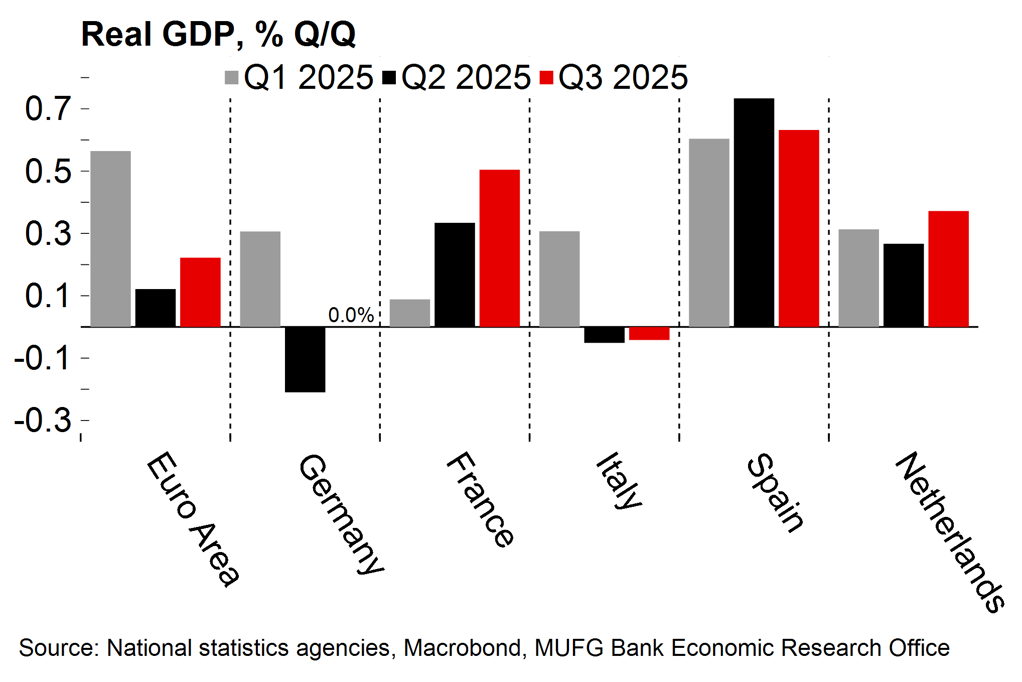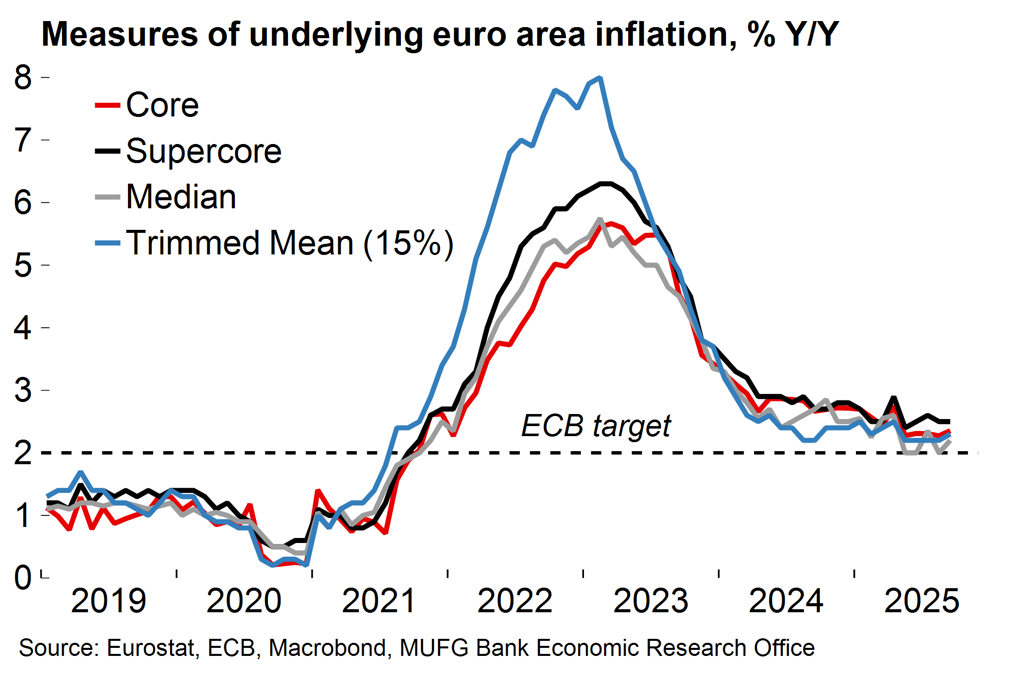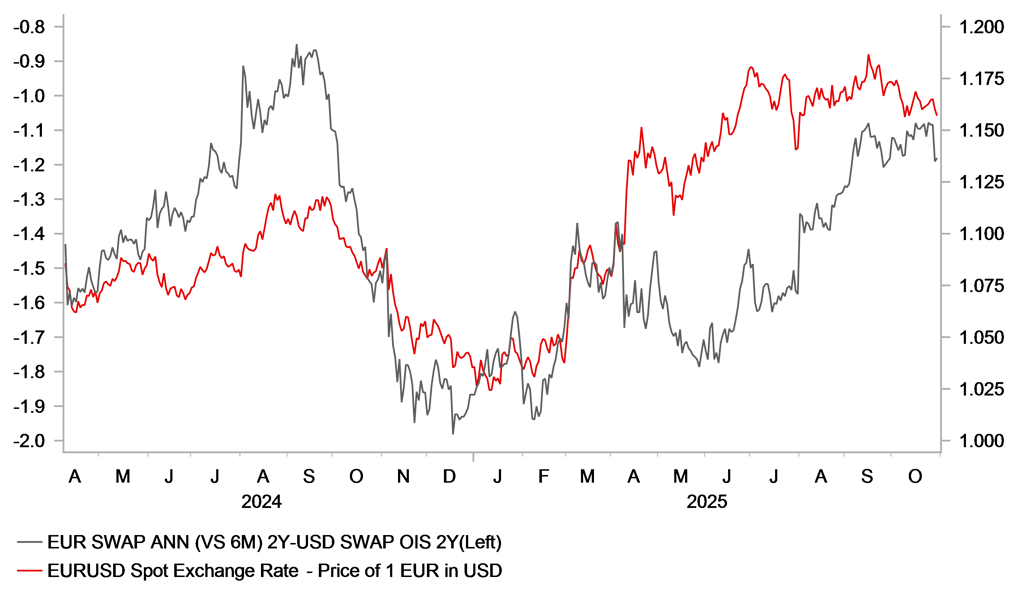ECB Review: All good, for now
- The ECB left its policy rates and guidance unchanged, as expected, in what was a low-key meeting in Italy. Lagarde said the decision was unanimous. There was increased optimism around the growth outlook and acknowledgement of fading downside risks to activity. The inflation outlook is less clear, however. We continue to think that officials will be forced to face up to the likelihood of headline inflation rates undershooting the target next year. The December meeting, with updated and extended projections, will be more interesting in that regard. For now, policymakers remain content with the current policy setting and the bar is clearly very high for any policy calibration at upcoming meetings.
- With the ECB sticking to its now familiar script, there were no obvious triggers for big moves in FX and rates. From a EUR-perspective this meeting gave us little reason for a change in view. The FX focus today though is on the fall-out from the FOMC meeting which could see EUR/USD extend lower, beyond our expectations.
Macro view: The bar remains high for any policy calibration
Everything’s tutto buono in ECB land
The ECB left the deposit rate unchanged at 2.00%, as expected, and made no changes to its guidance. Today’s meeting was held in Italy and it was essentially a passeggiata for policymakers with no surprises and steady messaging. Lagarde said it was a unanimous decision and went through familiar talking points, once again highlighting that the ECB feels it is in a “good place”. That was reinforced with a new passage in the statement which highlighted the resilience of the economy and comments from Lagarde which implied a view that risks to activity may now be tilted to the upside after the fading of obvious sources of risk.
The sense of optimism was likely reinforced by this morning’s flurry of data. Euro area Q3 GDP growth came in at 0.2% Q/Q, slightly above consensus after upside surprises in France (0.5% Q/Q) and the Netherlands (0.4% Q/Q). It’s worth noting within that there is still a considerable degree of fragmentation on a national basis with Spain still the star performer (0.6% Q/Q) but flat quarterly growth in both Germany and Italy. However, there are signs of improved momentum at the start of Q4 with today’s European Commission survey for October echoing the better signals from last week’s PMI.
Lagarde was more cautious on the prices front and continued to imply that risks around inflation lie on both sides. Again, that follows today’s data. There were encouraging signs of further disinflationary pressures in the services sector in the European Commission survey. The consensus is for the headline euro HICP figure to edge down from 2.2 to 2.1% in tomorrow’s release. However, the flash estimate of German HICP in October, released just before the ECB’s announcement, fell less than expected from 2.4 to 2.3% (cons: 2.2%). The details were mixed – the national CPI showed a sharp fall in food inflation (which helps with one hawkish concern) but services inflation edged higher to 3.5%.
The economy is showing general resilience to tariffs

Underlying price pressures are close to target

Could the ‘good place’ be better?
As we said in our preview, attention immediately turns now to the next meeting in December which will see fresh projections and so will be more interesting than today’s processional affair.
The ECB currently expects an undershoot on headline inflation from Q1 2026 until Q3 2027 despite the assumption of price pressures from the expanded emissions trading system (‘ETS2’) in 2027. Today Lagarde acknowledged discussion that the full implementation of ETS2 might be delayed or smoothed across 2028, which would reduce the immediate inflationary impact. We assume that the ECB will continue to work on the assumption of full implementation until any official announcement, but at some point it may be forced to confront a bigger projected undershoot.
The other thing to note is that the projection horizon will be expanded to 2028 in December. In the absence of evidence showing stronger price pressures between now and then, it’s certainly plausible that the central bank will project an undershoot on headline inflation across much of that horizon. That would undoubtedly present a challenge to maintain the ‘good place’ stance.
We continue to highlight the risk that the entrenched ‘good place’ mentality presents risks that policymakers are too static and backward-looking. We believe that officials may be forced to confront the need for further calibration (at least to the ECB’s lower estimate of neutral, 1.75) next year at some point. Our view is that cooling wage pressures, the stronger EUR and trade diversion are likely to increasingly weigh on inflation.
But the bottom line is that policymakers are clearly content with the current setting and it will take a lot to change that. Headline inflation has been within 0.2pp of the target since March and the deposit rate is at the central estimate of neutral. While Lagarde said that the ECB “will do whatever is needed to … stay in a good place” the bar is clearly high for there to be any change to policy at upcoming meetings.
Markets view: As expected ECB outcome with FX focus elsewhere
EUR holding key support levels with Lagarde offering little
The foreign exchange market has seen some bigger moves over the last 24hrs in response to the FOMC communications last night and the confirmation of a resolution to the latest trade tensions between the US and China. Today’s ECB statement and the press conference by President Lagarde has provided little further impetus to the increased price action. The fact that the statement maintained the “data-dependent” and “meeting-by-meeting” reference to the approach of decision-making going forward underlined the lack of direction the ECB continues to give the markets. It emphasises the message from the ECB of being in “a good place”. But the key takeaway looks to be that the ECB now sees the downside risks to growth as having moderated somewhat while the risks in regard to inflation are broadly unchanged. The EU-US trade deal reached in the summer; the ceasefire in the Middle East; and the US-China agreement were highlighted by Lagarde.
But the ECB view of reduced downside risks to growth has had limited impact on the markets. Front-end yields gapped higher today after the FOMC meeting last night but yields have softened modestly once the press conference began. EUR/USD was falling sharply to today’s intra-day low ahead of the policy announcement and has since recovered very modestly. The reality is that the broader dollar move is dominating FX moves today and the lack of direction from the ECB and President Lagarde leaves the dollar theme in place.
Today’s meeting therefore gives us no reason to change our view on the euro side of EUR/USD but of course on the dollar side of the equation the risk of the FOMC not cutting rates in December is a lot higher today and that could result in EUR/USD underperforming our expectations (1.2000 by year-end). We will be watching technicals in the coming days – will this dollar positive momentum see the range in DXY break to the upside? Since June DXY has traded broadly in a 96.000-100.00 range (bar two trading days to the upside). A break of DXY above the 100-level and the intra-day high of 100.257 (on 1st August) would force us to rethink our near-term US dollar bearish view. 1.1542 and then 1.1500 are the key support levels for EUR/USD.
FOMC / ECB MEETINGS SEE 2-YR SWAP SPREAD MOVE IN USD FAVOUR

Source: Bloomberg, Macrobond & MUFG GMR
